We all know that LEGO is the best toy company in the world. And in the Formula 1 community, one of the most (if not the most) popular teams is that of McLaren. As the second-oldest competitor, they have a lot of clout under their belt. They’re also known for being innovative in the world of racing vehicles. So it was only natural that the two joined forces to introduce the LEGO Technic 42141 McLaren Formula 1 Race Car. This 1432-piece set will be available beginning March 1st, and retail for US $179.99 | CAN $239.99 | UK £159.99. Come along as we hop in the driver’s seat to take a closer look and run her through her paces.
The LEGO Group provided The Brothers Brick with an early copy of this set for review. Providing TBB with products for review guarantees neither coverage nor positive reviews.
Unboxing the parts, instructions, and sticker sheets
The 18+ black box certainly shines here. It’s likely the LEGO packaging team would take a different approach if the new design didn’t come into play, but I really can’t imagine this looking better in any other format. The black, along with the orange greeble strip at the bottom really make the car colors pop.
You may notice that the top corner of the front of the box boldly states that this is the 2022 edition of the McLaren Formula 1 Team race car. But that’s not exactly true. Many folks probably couldn’t care less, but Formula 1 fans might find themselves a bit let down. Technically, this design was the last prototype from 2021. The timing of the LEGO release is a bit unfortunate, as the actual 2022 car was unveiled a couple weeks ago, with notable differences. But more on that later.
Inside there are 10 numbered bags 1-4, an unnumbered bag, and, of course, the tires. It’s immediately apparent that there isn’t a ton of meat to this set. To be honest, it feels like the initial assessment of the contents is that they don’t live up to the box size.
The thick instruction book, which boasts an awesome shot of the vehicle against a black background, does feel like it matches the exclusiveness of the set. Additionally, racecars mean sponsors, and sponsors mean lots of decals, so naturally, this set has quite a few stickers in it. An odd thing to note is that they came flat with the instructions in their own plastic bag/sleeve, yet the largest sheet was slightly wrinkled with bubbles. Fortunately, it doesn’t create a problem later.
Like the recent LEGO BMW motorcycle, the inside of the instruction manual pays homage to creators, both from LEGO and the F1 Team. The very first page shows a side-by-side comparison that is decent, however, it’s not nearly as flattering and true-to-life as the motorcycle.
The build
Building begins with the back differential and suspension, which is fairly straight-forward. At the same time, it quickly becomes complex in terms of the amount of stuff happening in a small space. But to be clear, complex does not equal difficult in this case. Actually, McLaren even made mention of a locking differential in their own press release, which would obviously make this more involved. But unfortunately it does not appear in the final model. The keen eyes of a diehard Technic fan may also feel as though they’ve seen this before. Indeed, it’s extremely similar to the Grand Prix Racer from 2013.
As previously mentioned, once the structure is mostly finished, there’s a lot going on. But it makes for a nice-looking suspension.
At this point you can’t help but play with it, though the springs are needed for additional stability and… well… spring.
You can see in the GIFs above and below that the addition of the springs certainly reduces the range of motion that the suspension has to offer. Of course, it’s not like these road-huggers are known for their wicked suspension.
And, naturally, you can’t help but play with the differential too, just to make sure it works (wink). Sadly, depending on how you look at it, this is the most complicated part of the whole 18+ set. In fact, aside from the typical issues of uncooperative pins, this set really isn’t much of a challenge or terribly interesting/exciting from a mechanical standpoint at all.
From here we break into that unnumbered bag and attach a giant 11×15 black frame. Now we’re ready to support the skeleton for the rest of the model.
Before the bones, we have to round out the guts with the engine block – another fun feature to “test”.
This concludes the steps for the bags labeled “1” and we’re ready to move onto the other half of the model. For now, we’ll set this one aside.
Bag 2 begins with a steering gear rack mounted in a 5×7 Technic frame – new in orange. This setup is extended the length of the long front end to an 8-tooth gear that controls the steering wheel. Also noteworthy, the suspension springs are held in place by 3L connector pieces that were last seen in an limited-run 2004 FIRST LEGO League set. Prior to that it was in a 2002 Bionicle set.
One of the most interesting techniques in the set is the compression of the front suspension springs as part of the build process. The springs slide into a groove before being locked into place, which is interesting because their “resting” state becomes slightly compressed.
After being locked in place, we have a mostly condensed, tidy central body. While the springs stabilize it some, playing with it at this point puts a little unnatural torque on the system, so it’s better to want until it’s fully secured.
Once complete, we have a suspension very similar to the back end. Ultimately, though, the front has a little more range of motion.
Now it’s time to apply our first stickers to the model – and some of the most difficult. At 1×1, you almost need tweezers to get them on at all, let alone properly placed. That said, I was able to manage it fairly well without them.
Totally new with this set are a pair of panels used above the wheels, as well as an incredibly useful 19×3 Technic frame, which I’m pretty sure I need a boatload of. These frames form and secure the sides of the newly-installed cockpit. They’re attached to the frame via “H” liftarms (in this case, “I”), which are new in black.
That concludes bag #2, along with the skeleton. The two halves of the model are now joined at the center, and are prepared for paneling.
A lovely handful of new parts are introduced in bag #3. Aside from the panels previously mentioned, we have four larger, triangular curved panels, appearing in black and blue for the first time. Also appearing in blue for the first time is the large 11×3 curved panel. The 11L blue liftarm hasn’t been seen since 2016. And last but not least, we have an entirely new part in the form of tiny 2×1 curved panels.
To start, both System and Technic elements detail the tail end of the model. This includes a couple of those nice new 2×6 tiles in black. Also, large sections are placed on the sides to fill out the width of the body and act as a base for the curves.
From there, we finally get to expand upon the blue side of the color palette. This is actually one of my favorite aspects of the build because there’s something organic and interesting about the shape. It’s almost like the giant maw of a whale or body of some unique insect.
Another cool feature can be found in the air inlets. Fins are attached to pneumatic elements on an interestingly composed frame. The technique and look are both quite satisfying.
Moving along, we get to the nose of the vehicle. The very front actually looks pretty rad, with those giant curved panels producing a nice shape. The new tiny panels also come in handy here, though the color is ever-so-slightly off from the surrounding pieces. On the other hand, the orange portion of the nose doesn’t have as pretty of a slope as the real deal. But when it comes to the constraints of LEGO, you win some, you lose some.
The steps of bag #3 conclude with the addition of a giant rotor that acts as a fin. It will give the peak of the vehicle its distinct airfoil shape. At this point, despite seeming small upon opening the box, it’s clear that this model is huge in terms of footprint.
Bag #4 provides us with another group of noteworthy elements. For starters, the 7-long curved panel is new in blue. New in orange are the suspension wishbone (used in the cockpit halo), 1×2 thin liftarm, the pin hole bush with attached axle, and the 1×3 modified crank. The orange 90° (#6) connector was last seen 2004 in that same FLL set previously mentioned. The orange 1×2 locking hinge plate was last seen in 2003, but as a different mold type.
We begin this set of steps with giant orange panel sections, which are loaded with sponsor decals.
When a model is sticker-heavy, it’s a real bummer to come across issues with those stickers. They are, after all, a focal point in this case. Unfortunately our model had a small amount of bleeding, most noticeable in the Gulf logo.
Connecting some additional orange sections (which include 11×3 curved panels, new in orange), all of a sudden the body is mostly closed up! It’s at this point that the mirrors are added to the build, but it feels a bit unfinished. There are no bush elements to act as spacers and keep the axles that act as arms in one place. Simply bumping them at the right angle will push them out of place, as seen here. This is not the only place where a bush is absent. Most of the time it doesn’t create a stability issue, but it sure doesn’t feel finished. I double-checked more than once to make sure I didn’t miss putting them on.
It may not matter to many people, but one of the biggest eyesores for me on this set is the DARKTRACE logo on the rear spoiler. The box and instructions have a large gap between the top and bottom stickers. Because I hated the look, I attempted to squeeze them closer together. The result is fair, but not great. The biggest letdown is perhaps how much of the decal is left behind on the sticker sheet. There has to be a better way!
As we come to the last few steps, we revisit some System elements in order to make the core for the top section. In this case, stacking the 1×2 modified plates on the newer 2L bar with stoppers is an interesting technique.
We finish up the build with the large wheels and their tires (last seen in the 2021 LEGO 76240 Batmobile Tumbler). Unfortunately, it’s a bit of a lackluster finale. Why? Well, first of all, the actual vehicle has back tires of a different width than the front (even displayed in the instruction book), while these ones are all the same. Also, we had our fingers crossed for printed tires, but alas, we are left with awkward round plates that require difficult-to-place stickers.
The completed model
As you can probably tell from the tone thus far, there aren’t a ton of high praise points here. When you look at it at the right angles, it certainly has a cool swagger to it, and you can appreciate the bold design. Love or hate the color palette, it certainly makes a statement and matches the McLaren F1 style well. For what it is (aside from comparisons) the shapes are pretty cool too.
Although it was previously discussed, it might be nice to take another look at that suspension.
As you can see, the finished structure reduces the range of motion, but again, this is to be expected. Perhaps I’m biased, because I’m more of a rugged vehicle person, but it feels weird to have spent such a significant portion of the build on suspension to have it be so limited.
If we take a closer look at the steering, you can see this aspect has a little more to it. That said, the halo and small nature of the steering wheel makes it really hard for adult hands to access. Plus, when the steering wheel is centered, the wheels aren’t, which is likely a product of the necessary 8-tooth gearing. But this is a nitpicky complaint.
Again, as a Technic vehicle, it looks fairly slick. You can certainly appreciate the body shaping, although it’s not mind-blowing in terms of its comparison to the real thing. Also, it’s important to reiterate that this in not the McLaren F1 2022 model, as advertised. The recently revealed car has slightly different colors (and pattern), different shapes, different wheels, and different sponsors. In some ways, it’s a completely different car.
Conclusions and recommendations
Let’s imagine a Venn diagram for a moment. There are LEGO Technic fans, Formula 1 fans, and fans that are in the center where those two meet. Or, we could even look at it as a sliding scale from average AFOL (Adult fan of LEGO) to diehard F1 fan. Where do you fall? If you’re curious, I’m a life-consuming AFOL with some special interest in Technic. I’m not well-versed in Formula 1, but I respect the aesthetics. I also did a fair amount of research for this article. So what’s my take?
You may have already guessed where this is going. For the majority of people, I believe few could appreciate this set in its entirety. A casual AFOL with a pocket full of cash and no knowledge of F1 or a diehard F1 fan with little previous LEGO experience might find this model to be a great display piece – which is wonderful! To each their own. Otherwise, to be blunt, it’s honestly underwhelming and overpriced. It’s rare that I don’t recommend a LEGO model to some demographic. But unfortunately I have to admit that it might be the last Technic set I would encourage anyone to buy from this or any other recent wave.
LEGO Technic 42141 McLaren Formula 1 Race Car includes 1432 pieces and will be available beginning March 1st, retailing for US $179.99 | CAN $239.99 | UK £159.99.
The LEGO Group provided The Brothers Brick with an early copy of this set for review. Providing TBB with products for review guarantees neither coverage nor positive reviews.





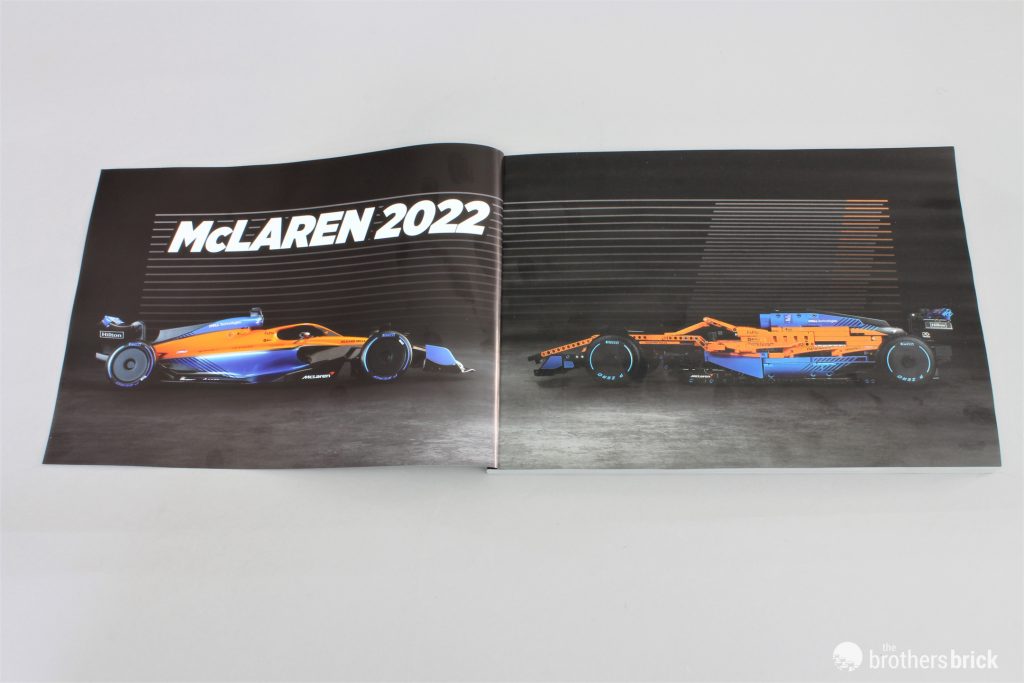























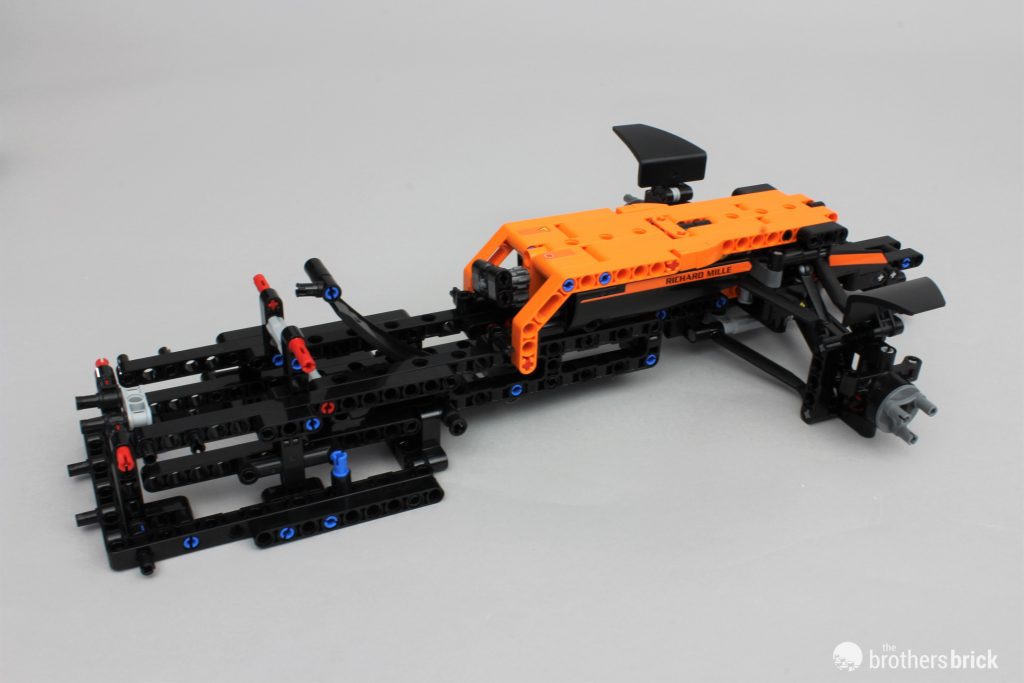



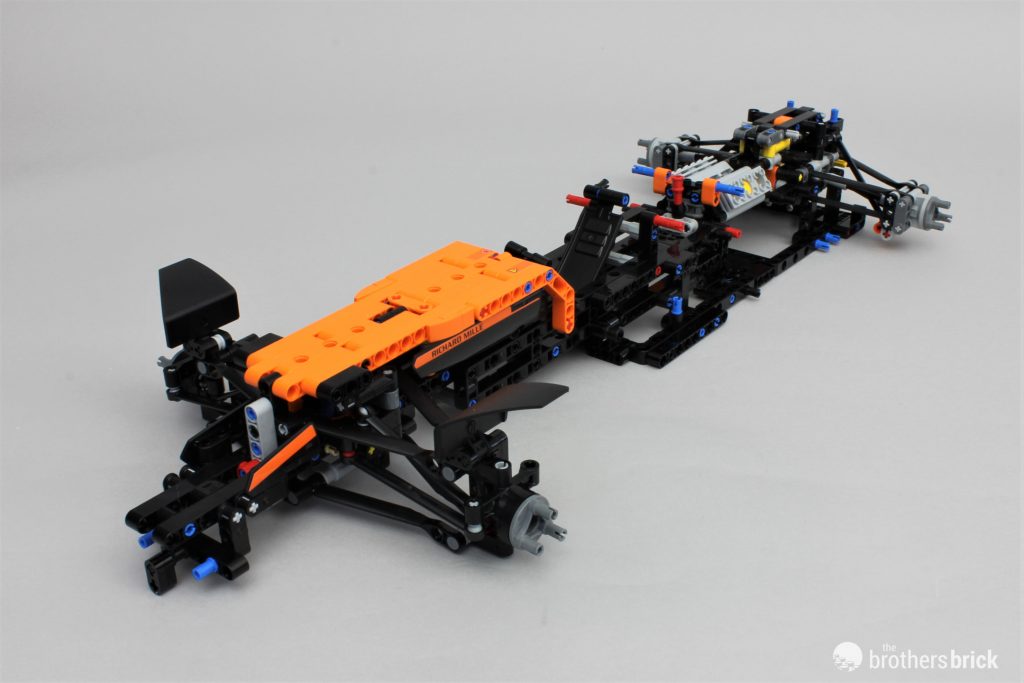


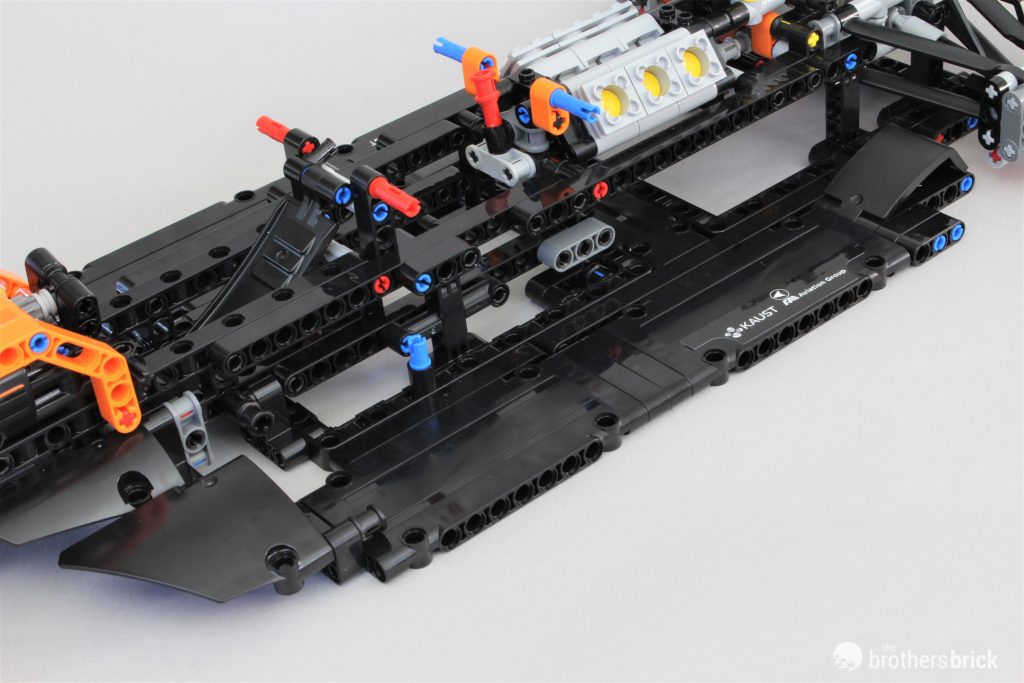



















































































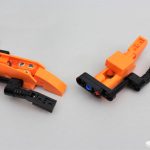























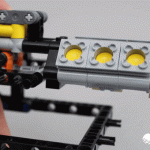





Ironically, this will be one of the first technic sets I will buy in a long time. Avid AFOL and also an F1 fan so I think this one is inevitable for me.
One note on the livery vs the shape. The shaping of the car is based on the 2022 car (loosely as McLaren was still hiding their new car). The color theme is based on the 2021 car as McLaren kept their new colors under even tighter lockdown until the reveal shortly after this set was revealed. Personally I actually like the cross between the two cars and I prefer the 2021 livery and the 2022 styling.
Too ugly. Waiting for the next super car collab
For the record, this set is more robust than last year’s Ferrari +18 Technic set. If one wants an F1 racer, the Grand Prix racer from 2013 seems to be a better bet. The average price for a used copy on Bricklink is $127.
As Xtopher said, this is the 2021 livery put on the 2022 show car that the FIA produced. It’s actually a good representation (both model and livery) of what’s on the f1 website.
https://www.formula1.com/en/latest/article.must-see-check-out-the-teams-2021-liveries-on-the-2022-f1-car-they-look.5Wff5hD3BtzHNWbbArPVcv.html
They skirt around this by not calling it the MCL36 on the box, and honestly Lego were not going to be given access to the design ahead of launch so it would have taken months to get the set out.
Interestingly, the set doesn’t have the nicotine sponsors that the actual car does, and they are bigger on the actual 2022 car which would have left a lot more blank space.
As an F1 fan, Technic and System AFOL, I really wish they’d just pick either technical features or Creator type display vehicle.
This set is an annoying spork, doing neither as well as it could.
It’s a common complaint I have with multiple technic sets, and I think I’m probably mostly alone in this, but that is my opinion and what drives my purchasing decisions.
I had this in my basket until I read the review
Ouch – that’s a disheartening conclusion. This is only my 3rd LEGO set, McL Senna & Ferrari 488 Technic. I am an F1 and racing fan and just now learned that LEGO even had sets like this when the new Speed of Champions Mercedes W12 set was announced. I love F1 snd modelscale so that’s why I bought this and the Merc sets. I haven’t even finished building the Ferrari yet and have ordered 4 or 5 other car sets including a couple knock offs. I’m really excited to see what these LEGO sets look like when they arrive. I totally impressed with the 488 Technic, I had no idea there were sets this detailed or advanced.
If you pull the steering wheel off and the 2 pieces in front, the gear and bushing, the top piece spins freely and you can line it up to get the steering wheel to sit straight without taking it all apart. I almost tore it down then caught that
The wheels / tires of this kit have always felt lackluster for me, so I dealt with it!
Now I can finally start building this mega beauty!
If you fancy yourself a set, point your browser to -> https://www.inspyre.ca/product/tire-wheel-decal-sticker-kit-for-lego-mclaren-f1-team-2022-kit-42141-pirelli-p-zero-cinturao-c2-c3-c4-wet/)
This set is a functioning example of a pushrod suspension setup. I’ve taken this next line verbatim from wikipedia “As such, push-rod suspension systems allow for much greater high-speed stability, much lower levels of body-roll, and a much lower centre of gravity for the vehicle”
An all terrain vehicle with an expectation of a ‘suspension thats reallly bouncy’ would make for a shit f1 car.
For me this is a must get.